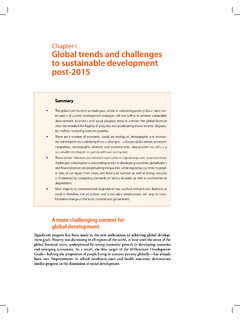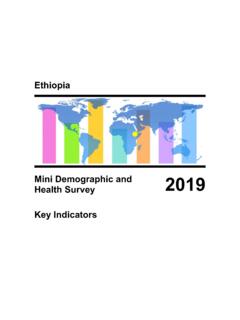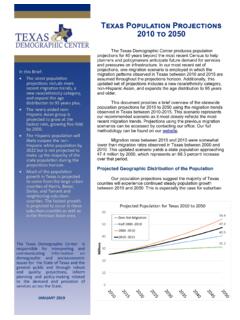Transcription of The 'sandwich generation': women caring for parents and ...
1 Monthly Labor ReviewSeptember 20063 The sandwich generation : womencaring for parents and childrenData from the National Longitudinal Survey are used to estimatethe number and characteristics of women 45 to 56 years oldwho care for both their children and their parents ;these women transfer a significant amount of moneyto their children and time to their parentsCharles R. PierretCharles R. Pierret isDirector ofLongitudinalSurveys, Office ofEmploymentand UnemploymentStatistics,Bureau of views expressed inthis articleare those of theauthor and do notnecessarily reflect theposition ofthe Bureau of LaborStatistics orDepartment of term sandwich generation has becomeincreasingly common in the United Statesover the last two decades.
2 In a collectivesense, the term has been used to describe themiddle-aged generation who have elderly parentsand dependent In the individual sense,the term describes people who are squeezedbetween the simultaneous demands of caring fortheir aging parents and supporting their dependentchildren. This article uses the term in the individualsense and estimates how many women 45 to 56years old are part of the sandwich generation basedon data from the National Longitudinal Survey ofYoung women (NLSYW). It examines demographiccharacteristics of these women and the type andamount of support they give to their childrenand size of the sandwich generation dependson how one defines it.
3 An AARP report found that44 percent of 45- to 55-year-olds had both at leastone living parent and one child under age 21. Only7 percent of 45- to 55-year-olds, however, lived in ahousehold containing three generations; usuallyoneself, one s parents or in-laws, and one Support, of course, can mean somethingother than co-residence. parents may providefinancial support to their nonresident children forcollege expenses, the purchase of a home, or justas gifts. They may also provide help with childcareor household errands. Adult children can likewisehelp their elderly parents with personal care orerrands, or with financial assistance, even if theydo not live a sense, the sandwich generation is not a newphenomenon.
4 Elderly or infirm parents historicallyhave been cared for by their children, often withinthe child s home. The increased attention to thesandwich generation in recent years probably hasits roots in many demographic As lifeexpectancy increases, more middle-aged peopletend to have parents who are still alive. Addi-tionally, these parents probably have fewerchildren, so there might be fewer siblings withwhom to share the burden. Adult children are morelikely to live further from their parents , makingdecisions about caregiving more complicated anddisruptive.
5 women are having children at later ages,so their parents are older, but their children are stillyoung. Support for children might last longer thanthe support received by their parents generation,often reaching into the early and even mid-20sas they attend college and establish their ownhouseholds. women are more likely to work out-side the home, making it increasingly difficult toprovide additional caregiving services. Interestin these problems is undoubtedly due to the factthat they are being experienced by the baby-boom generation, a group that, by its sheer size,garners a large amount of media article determines what proportion ofmiddle-aged American women can be classifiedas part of the sandwich generation.
6 Using datafrom the NLSYW and its 1997 and 1999 sectionson intrafamily transfers (that is, money or hoursprovided to another family member), this articleprovides estimates based on various definitions The Sandwich Generation "4 Monthly Labor ReviewSeptember 2006 The Sandwich Generation of membership in the sandwich generation. It concludes that,depending on our definition, somewhere between 1 percent and33 percent of 45- to 56-year-old women are simultaneously caringfor their parents and their children. The preferred estimate is that9 percent of these women are giving a significant amount of careto both their children and their parents , and can be termedmembers of the sandwich National Longitudinal Surveys (NLS)
7 , sponsored by the of Labor Statistics, are a set of surveys designed to gatherinformation at multiple points in time on the labor market activitiesand other significant life events of several demographic groupsof men and The Young women s cohort was started in1968, with 5,159 women ages 14 to 24 as of December 31, designed to include 5 annual interviews, the surveywas conducted 22 times before it was discontinued in 2003. In1999, the Young women were 45 to 56 years old and wereinterviewed for their 20th time. The retention rate 31 years afterthe initial interview was percent of those respondents whowere still living.
8 In general, respondents participated in 1-hourpersonal interviews. The questions have always focused onlabor market activity, but this has generally been interpretedin a very broad sense to include any activities that affect orare affected by one s participation in the labor market. Thus,questions on education and training, child care, marriage andfertility, household composition, attitudes and expectations,criminal activity, government assistance programs, and othertopics have complemented the extensive labor market infor-mation gathered from survey 1996, NLS management designed a section of the NLSYW questionnaire devoted to transfers of time and money amongfamily members.
9 The idea was to explore the web of connec-tions linking respondents to their parents and adult , the section proved longer than the 15 minutesavailable for its administration. Therefore, the questionnairedesigners split the section into two parts. In the first, administeredin the 1997 survey, respondents were asked about transfers totheir parents . The second part, asked in 1999, focused on re-lations with the respondent s adult 1997 parent section begins with an enumeration of arespondent s parents ,5 either living or deceased, and those ofher husband.
10 For each of these parents , information aboutage, health, and residence is also collected. Respondents thenprovide information about the financial situation of theirparents by answering questions about parental income andthe net worth of the parents assets. After this basic back-ground information is collected, the 1997 survey collectsextensive data about the amount of time and money therespondent spends assisting living parents and could involve up to four separate households if both arespondent s parents and her in-laws were no longer livingtogether.


















